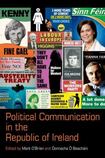
The title Political Communication in the Republic of Ireland reflects this book's academic origins, but it reads like an insider's guide to life in Leinster House and editors' offices. This is the first time that Irish-style political communication – or spin, or propaganda: call it what you will – has got an impartial examination.
Its editors, Mark O’Brien and Donnacha Ó Beacháin, of Dublin City University, have drawn together contributors from across the political and communications disciplines to cast their authoritative eyes over Irish political discourse.
The unvarnished facts and candid interviews that are the results of the authors’ research are fascinating. And it is not just about the political machinations of Government Buildings: the part played by local radio and local newspapers, as well as by social media, is explained.
The opening chapters cut to the chase. Politicians have a symbiotic relationship with journalists: politicians need the profile and journalists need the copy. We are told that the kind of democracy we have is formed by the political knowledge that citizens gain from the media. For many, general elections are their only real interaction with political communication – and, far from televised debates, focus groups, opinion polling and slick advertising campaigns, door-to-door campaigning is still its mainstay in Ireland. Despite advances in social media that our electoral system encourages, “Irish voters are not quite ready for an exclusive virtual relationship with their public representatives.” It is this type of academic analysis that makes the book so interesting.
The relationship between local politicians and regional newspapers and radio stations opens up an area that is rarely discussed or examined. Here we discover that the advent of the “constant campaign” has meant that maintaining a local profile is essential for politicians. The chapter details interviews with newspaper editors, with heads of local-radio news, and with TDs and their assistants. The quotes spill the beans on this “pragmatic partnership”. We discover that while 57 per cent of people read a local paper (outside Cork and Dublin), local radio is still the focus. Increasingly, major news stories are broken on local radio. Local editors often ignore releases from central press offices. I wonder why that is.
Unencumbered by radio’s legal requirement of balance, one unnamed newspaper editor is clear on the issue of quantity versus quality: “There is no doubt that the TDs who put out a regular stream of press releases get much more publicity than those who don’t. It’s indicative of a mindset.”
Overlooked realities
This book brings to life the obvious yet often overlooked realities of political communication. The development of political journalism in Ireland has mirrored the development of the State itself.
The increasing speed of the media cycle raises the question of whether a true and deliberative democracy can exist. If you can tweet a question or opinion as a story breaks, can we expect a considered response?
Mark Byrne’s chapter on the relationship between the Government press advisers and journalists is a must – and, arguably, should be on the school civics curriculum. Byrne focuses on advisers who had been journalists, making the leap from “batsman to bowler”. It becomes clear that they work not only with senior politicians who can be “extraordinarily naive” about the media but also with journalists hungry for news.
Seán Duignan of RTÉ, a former press secretary for the Fianna Fáil-Labour government, blows away the idea of the all-powerful spin doctor. “Politicians never understand that you can’t ‘handle the media’,” he says. “The media isn’t in the business of saying ‘good day for the Government’.” Never a truer word spoken.
John Murray was deputy government press secretary for Mary Harney from 1997 to 2000. He agrees with Duignan: politicians are wrong if they think that pumping out good news to the media is the function of the Government Information Service.
The relationships between the press secretaries from different coalition partners, as detailed in this book, range from having no contact with one another to holding joint press briefings, with varying success. The anecdotes – best left in their full context – will bring a smile to the sternest faces.
Powerless spin doctors?
The idea that the spin doctor is relatively powerless before “public sentiment, voracious and expanding media and the current political landscape” will be news to many.
Today much is made of social media's potential to change political communication. The public-relations lecturer Martin Moloney comes to a revealing conclusion when he looks at the impact of Twitter and Facebook on recent elections, including the 2011 presidential election and "Twittergate", when Pat Kenny, on The Frontline, read out a tweet about Sean Gallagher purporting to be from Sinn Féin: "The most beneficial use of social media – that of real engagement with the electorate – is likely to be ignored."
What makes this book a trove is its lack of partisan politics. The detached, measured view offered by the assembled academics rings true to anyone involved or interested in political communication. This is a good insight into politics for genuine hurlers on the ditch and for devotees of the black art.
Brian Hayes is Fine Gael MEP for Dublin










